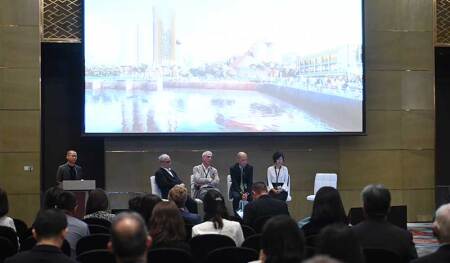
From left to right: moderator Sada Lam, director, Oval Partnership; Shiling Zheng, president, Tongji Architectural and Space Research Institute; Filippo Gabbiani, founder and principal architect, Kokaistudios; Bryan Tang, executive director of Lifestyle Group; and Xiaohong Kang, Shanghai West Bund Development Group, speaking at the 2019 ULI Asia Pacific Summit in Shanghai.
Though the postcard photos of Shanghai’s gleaming Pudong district are familiar, fewer people are aware of the large numbers of heritage properties the city is conserving and regenerating. Panelists at the 2019 ULI Asia Pacific Summit in Shanghai discussed several innovative approaches to regeneration of Shanghai buildings and neighborhoods. Notably, even the projects that required wholesale redevelopment of moribund sites did not simply lay waste to the city’s past.
Shiling Zheng of the Chinese Academy of Sciences provided an overview of the scale of Shanghai’s regeneration opportunities. The city has 20 million square metres (215 million sq ft) of historic buildings, he said, with the Huangpu River providing a crucial thread to link several districts. Shanghai’s government has begun digging 27 tunnels under the river to ensure that it does not divide the city.
Impact of Urban Regeneration in Shanghai takes into consideration of the history of development and its symbolization of its identity of the city. The historical landscape of the city runs across from macro to meso to finally micro environment #ULIAPsummit @OvalPartnership pic.twitter.com/FcFu5LHQeE— ULI Asia Pacific (@ULI_AsiaPac) June 11, 2019
At the beginning of 2018, the metropolitan government announced the Shanghai 2035 plan, its vision for the coming 17 years. The city’s ambitions include expanding the metro network from 666 kilometres to 1,000 kilometres (414 to 621 mi), capping the long-term population at 25 million, and doubling the number of foreign visitors. Shanghai also wants to expand the amount of greenery in the city, with the goal that 90 percent of residents are no more than a five-minute walk from a park.
The river is a key feature in one of Shanghai’s major regeneration projects—the West Bund, which occupies 9.4 square kilometres (3.6 sq mi), with 11.4 kilometres (7.1 mi) of waterfront and a total planned development area of 9.5 million square metres (102 million sq ft). The city master plan calls for the West Bund to constitute by 2035 “a high-quality downtown public space offering innovation, creative, cultural, and other core functions of a global metropolis,” said Xiaohong Kang of Shanghai West Bund Development Group Co., the state-owned enterprise responsible for the regeneration.
The West Bund site has had many functions in the past—the city’s first airport, a major railway station, a huge cement factory, and a river port. Its transformation began in 2008 and is ongoing, with use for several projects, including the Shanghai World Expo 2010 site, now transformed into public space. The centerpiece of the regeneration is the riverside itself, which has been transformed “from rust belt to Shanghai Corniche,” said Kang. The riverside park now attracts up to 20,000 people on a summer’s evening. The area’s commercial heritage has not been forgotten: the waterside cranes from the area’s use as a port still stand as industrial sculptures on the waterside.
Part of the West Bund is the Shanghai Dreamcenter, introduced by Sada Lam, director at the Oval Partnership. The one-square-kilometre (0.4 sq mi) site, formerly home to the cement plant, includes one kilometre (0.6 mi) of waterfront, which is linked to the rest of the riverside. The project is to be completed in 2020, providing a creative and lifestyle destination.
Not all Shanghai’s regeneration projects are of such massive scale. “Shanghai has multiple historic resources,” said Filippo Gabbiani, founder and principal architect at Kokaistudios. He discussed the transformation of Huai Hai Lu 796, a derelict building in Shanghai’s historic French Concession. It began life as the villa of a China trader and was repurposed as a cinema for propaganda films, but had been derelict for 30 years before Kokai breathed new life into it.
The original fittings and features were carefully restored and updated in an effort that took into account that modern air conditioning can destroy aged woodwork. The villa was transformed into a luxury retail destination, home to Swiss watchmaker Vacheron Constantin’s China flagship store and the exclusive Kee Club.
Bryan Tang, executive director of Lifestyle Group, talked about Bridge 8, an urban regeneration project. It grew out of the less-than-glamorous abandoned factory buildings of the Shanghai Automotive Brake Company and expanded to regenerate surrounding buildings. Lifestyle Group has managed to turn a series of grim industrial structures into the type of modern, light, and airy commercial space favored by creative industries.
Lam listed five key features for successful regeneration: a compelling narrative, community, the highest-quality public realm, a meaningful cultural element, and a mix of uses.




